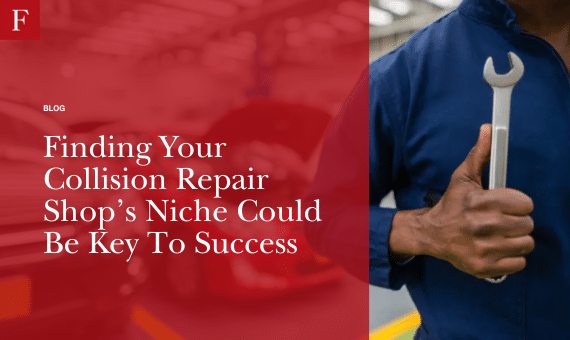
Finding Your Collision Repair Shop’s Niche Could Be Key To Success
Michael Giarrizzo Jr. said focusing on certain manufacturers — along with other strategies — has helped his company, DCR Systems, grow.
One of the most interesting and innovative operators in the collision repair industry, Michael Giarrizzo Jr. is the CEO of DCR Systems, a dealer-focused body shop group with four distinct business units and 10 locations, including six independent and four licensed franchise shops.
Giarrizzo spoke to Cole Strandberg, host of The Collision Vision podcast, driven by Autobody News, about his 19-year-old company’s unique business model and the current and future challenges of the industry as a whole.
EARLY CHALLENGES AND LUCKY BREAKS
Giarrizzo is a third-generation repairer. His grandfather started a mechanic shop in 1946 and his father opened a collision repair shop in the 1960s. From there, they built a family business, which Giarrizzo joined after finishing school, that grew to four locations before being acquired by Sterling Autobody Centers in 1999.
Giarrizzo launched DCR Systems in 2005, a series of independent collision repair centers, each connected with a local automotive dealer.
Giarrizzo said DCR Systems’ business model proved to be ahead of its time when it opened in 2005, as repairs have become more specific to each car brand over the nearly two decades since.
“It’s really gone to where if you don’t have this specific training for the manufacturer, you don’t have a whole lot of business touching that vehicle,” Giarrizzo said. “No longer is it [just] about how pretty that repair is. It’s peeling back the onion and understanding, is this car actually reconstructed in a way that it’s going to respond the same way?”
DCR SYSTEMS’ BUSINESS MODEL
Giarrizzo described DCR Systems’ four business initiatives, all connecting to the mission to deliver consistency and quality.
“One is stores that we operate,” he said. “We’re technically an independent. But we connect with auto dealers, sometimes even co-brand with them, represent them through certification.”
Second, DCR Systems now has licensed franchise stores. It began licensing just before the pandemic, and now has four.
“That’s been an eye-opening experience,” Giarrizzo said. “When you hand your playbook off, can somebody else implement it? Can they grasp what that vision is through that playbook and be able to execute it? And how do we support that? So that’s been an interesting endeavor.”
Third, DCR now has a location that performs calibrations, and a second in the works.
“The main reason there, again, is around that safe and proper repair and making sure that we can take responsibility for that calibration and know that it’s done correctly,” Giarrizzo said.
Some of DCR Systems’ niche stores, focused on one or two manufacturers, also do their own calibrations to those automakers’ standards, Giarrizzo said.
The larger location supports more than a dozen manufacturers, and has grown to the point it is taking on outside work.
“[Calibration] is important today and you fast forward another five or six years down the road, it becomes even more important,” Giarrizzo said.
Fourth, DCR Systems developed CollisionClarity, its own software application that “essentially forces us to document everything that we do, whether it be through pictures, videos, position statements, manufacturers work, instructions, any industry supportive documents that we’re building,” Giarrizzo said.
The software then matches that supporting documentation to line items on a repair plan.
DCR Systems’ shops have “a completely tooled environment where we own every tool, every piece of equipment, all set up strategically by the people doing the work,” Giarrizzo said.
The technicians also complete formal quality verifications after every key step before moving on to the next, documenting them manually and electronically.
It’s all part of an effort to ensure a consistent, quality repair that creates a “customer for life,” Giarrizzo said, which is not as easy for DCR Systems, since its shops are “out of network” for insurers.
“It’s a challenge for preparing the customer without scaring the customer, and then working out a reasonable settlement [with their insurer] without compromising the work that we’re going to do,” Giarrizzo said. “It’s not the greenest path. So we don’t suggest everybody run out and try this at home.
“You have to balance between that customer experience and that concession that you’re going to make. It really digs deeply into our profitability and our ability to reinvest in the company. So it’s a balancing act today,” he said.
ESTABLISHING PARTNERSHIPS WITH DEALERSHIPS
Giarrizzo said independent repairers interested in developing a similar business model must realize it’s a huge risk for a dealership to refer a customer.
“We’re representing [the dealership],” Giarrizzo said. “That customer is going to perceive that the dealer’s part of that experience.”
The independent shop must assure the dealership it will be well represented, and the customer will get a safe and proper repair with OE parts.
METRICS TO MONITOR, IMPROVE BUSINESS
Giarrizzo said a lot of the metrics DCR Systems tracks are related to the customer’s experience. He said the company also tracks performance indicators for its relationship with its dealership partners.
“We don’t have really the traditional metrics that you see coming out of our industry,” Giarrizzo said. “Ours are on that leading edge looking for ways that we can actually fix something before it impacts the customer.”
For instance, DCR Systems classifies a “unit” as $100 of labor, regardless of the type of labor. That creates “a much more level playing field amongst our stores,” Giarrizzo said.
The shops also measure “units to ready,” meaning a car that is ready to be completely repaired, with an audited repair plan, received and verified parts, and completed mechanical and structural work — a car that is “essentially ready for the finish line, which involves body repairs, prep, paint reassembly, detail,” Giarrizzo said.
“If we’ve got this ready inventory, 10 cars that are all kitted for completion right there, our priority becomes output,” Giarrizzo continued, looking at what the system needs to move faster — be it more people, solving a parts backup or simply more cars in the door. “We’re trying to balance that out on a daily basis to simulate a continuous, even flow. It works.”
Strandberg acknowledged a lot of the terminology Giarrizzo used is more in line with manufacturing and production, as opposed to collision repair.
Giarrizzo said “lean production” has become a buzzword over the last 20 years. He first learned about what would be considered “lean principles” while working as a regional manager for Sterling Autobody Centers in 2000, where they developed a “simple but not easy” concept of moving from a teardown to a strategic disassembly, to identify everything needed to complete the repair before it is started.
“We call it ‘pre-op’ for good reason,” Giarrizzo said.
THE FUTURE OF THE INDUSTRY
Giarrizzo said DCR Systems will be offering its CollisionClarity software to the industry in the next three to four months. It recently contracted with another firm to help optimize the user experience.
He said shops will likely need to become more “niche,” specializing in repairing two to four manufacturers’ vehicles to their specifications.
“Maybe those manufacturers are kind of clustered together, whether it be German brands or domestic brands or whatever it might be,” he said. “The main thing is to know your niche, become that expert, figure out how to market to that. That’s where we’re going.”
KEY TAKEAWAYS
1. If you don’t have a niche, create one. If you do, find out how to advance and build around that.
2. Change the way work is done to attract your future. Break down your process to help expedite the training and knowledge for tomorrow’s workforce.
3. Documentation, documentation, documentation. Proving you did good work is becoming more and more important every day.
This article was previously published on AutoBody News.














